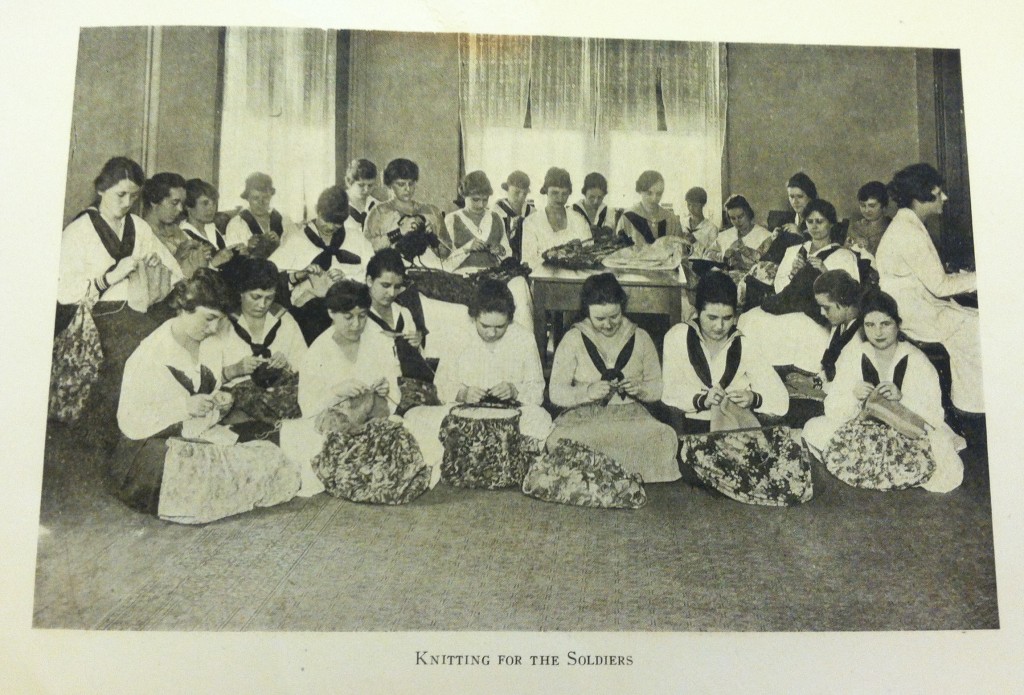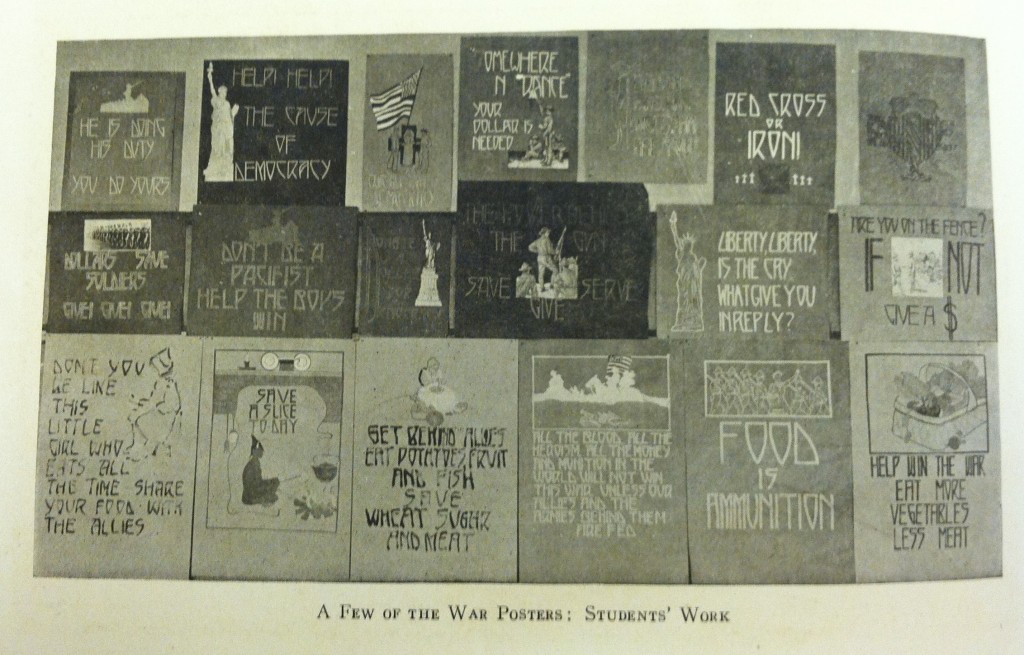Disclaimer: The first time I attempted to write and publish this post, WordPress lost all of my text changes. It was an hour and a half wasted because I couldn’t recover anything and now must rewrite the entire post again. Such a typical Monday.
This past Thursday I went back to Special Collections in order to do some more research for my areas of the site: Academics and Student Life. Way back at the beginning of the semester, Julia, Jack, Candice, and I visited Special Collections and got some great preliminary information from sources on the homefront experience at the Fredericksburg State Normal School. I wanted to go back and take a look at some of the catalogs that had not been digitized, due to their fragile condition, and to see if Special Collections had anything about certain clubs, like the YWCA or Red Cross Club. I took a look at the 1918-1921 catalogs, so that I could compare course offerings during and after the war (and because these are not digitized, with the exception of the 1921 catalog, but it was there while my laptop was not). It was tedious to go through each catalog, but I found some great information about academics and other areas of SNS life. The June 1919 catalog lists a War Activities faculty/staff committee, which Bunyan Y. Tyner chaired. I asked Mrs. Parsons if Special Collections held anything pertaining to this committee, but she said they did not. We did take a quick glance at Tyner’s papers, but they do not begin until the 1920s. The June 1919 catalog also has a short section on War Work at the school, and it contains a lot of information about the YWCA’s contribution to the war effort. In 1918 and 1919, student enrollment in the YWCA was around 75%, and it jumped to 96% in 1920! This drastic increase surprised me–I would have thought that an increase in membership would have occurred during the war, not in the postwar years. But, perhaps the YWCA benefited from its great contributions during the war and gained membership afterwards.
Academics-wise, some very interesting changes occurred in course offerings during and after the war. The most interesting changes took place in the History and Foreign Languages departments. The June 1920 catalog lists several new history courses, one such being “History Epochs,” which included the recent World War. The History department also offered several courses on “Hero Studies.” The American Hero Studies course is described like so: “This is a course designed to help those who expect to teach history. Stories of the most important characters are taken up and discussed in order to give the students a thorough knowledge of the greatness of those who have contributed to the making of America of to-day.” There was also a “Greek and Roman Hero Studies” course. I strongly suspect that the US victory in the war influenced the creation of these classes, especially because the tone of the American course is so triumphalist. (The parallel between American heroes and Greek and Roman heroes should also not go unnoticed–heroes in the birthplace of democracy and republicanism, and heroes of the world’s best example of democracy.) I find this hero-worship interesting, because it seems to contradict what we read about in Kennedy and what we have discussed in previous class sessions.
In the Foreign Languages Department, the 1918 catalog places a new emphasis on the importance of French: “In the last year our country has been brought into such close relationship with our ally, France, that it is almost a misfortune not to have some knowledge of the French language. Hardly a day passes that we do not find French phrases in our daily papers. For this reason one of the most practical subjects that the students of to-day can take is French.” Wow! This paragraph is great for 2 reasons: it speaks to the foreign relations and America’s escalated involvement in the war (especially compared to the 1917 catalog, which has no justification for taking French and simply lists the courses), and it reflects opinions about the universal utility of French. I particularly like that the catalog doesn’t specify who the “students of to-day” are to whom it refers. The Fredericksburg State Normal School was for women, primarily those interested in teaching, but it specifies neither gender nor profession–it just says “students of to-day.” (This lack of distinction is even more apparent when compared to the above description of the American Hero Stories history course.) I’m not quite sure of what to make of this lack of distinction, but I find it interesting nevertheless. Perhaps it speaks to how the war effort and Wilson’s “mobilization of emotion” tried to capitalize on a singular “American” identity, rather than an American identity with many different facets.

UMW Special Collections, June 1918 Academic Catalogue, Fredericksburg State Normal School, page 93. Photo copyright Leah Tams.
The 1918 and 1919 catalogs also list “Home and School Gardening” courses, which seem to be similar to their “Agriculture and School Gardening” predecessor, but with a new emphasis on conservation and preservation. We have also seen this new emphasis in a special course on Food Conservation for the war, listed in the April 1918 school bulletin. The January 1919 bulletin (also previously examined by our group) has a special section devoted to “war gardens” and its galvanization of the popularity of school gardens. It seems that even small facets of life were touched by the war!
I asked Mrs. Parsons about club records in Special Collections, especially the YWCA and Red Cross Club. She very graciously let me peruse the archival holdings on my own, and I was able to find a folder with information and documents from the YWCA. Sadly, they date back only to the 1940s. We were not able to find any folder on the Red Cross Club, but I did find one with general information about clubs, and the very first item in the folder is actually really helpful: it is a list (almost an inventory, if you will) of clubs at the Fredericksburg State Normal School from 1913 to 1919. The list bases its count on the clubs that appeared in each Battlefield Yearbook, and it includes clubs added each year after 1913 with a category “Clubs Added in [Year].” It is a useful source for gaining general insight into an aspect of student life.
One of my other favorite finds, besides the academic catalogs, was the “viewbooks” that Mrs. Parsons brought me. Special Collections only holds two viewbooks: one ca. 1919 and one ca. 1921. The school produced the viewbooks, and they are essentially short photo albums for students–each page has a singular image and a caption underneath it. The 1919 viewbook had two images in it that I would love to use for the website. The first one shows a group of students knitting, with the caption “Knitting for the Soldiers.” I think this image is so cool because I myself am a knitter, so it’s really awesome to see that 100 years ago, my predecessors at this school were also knitting, and they were doing it for a great cause (I like to think I knit for good causes, too).

UMW Special Collections, Viewbook, Fredericksburg State Normal School, ca. 1919. Photo copyright Leah Tams.
As cool as the above image is, another one was even cooler: it is a collage of war propaganda posters, created by the students! The caption beneath the images says, “A Few of the War Posters: Students’ Work.” Wow! So not only were our ladies knitting for soldiers, planting war gardens, and doing many other activities to help the war effort, but they were also creating their own propaganda posters to help war efforts! I’d like to know where these posters ended up being displayed. Campus? Fredericksburg? Both. I’ll probably never know. I asked Mrs. Parsons if any of these posters were in Special Collections, and she said no, unless they were hiding in some obscure place that she had never seen. Either way, I definitely want to get that page of the viewbook digitized so that we can include it on the site. UMW does have a collection of WWI posters, donated by someone who wanted them to be in a safe place, and many of them are French. I think it would be interesting to maybe compare the students’ posters with UMW’s collection and see what sort of similarities and differences there are!

UMW Special Collections, Viewbook, Fredericksburg State Normal School, ca. 1919. Photo copyright Leah Tams.
I’m hoping to make one last trip to Special Collections soon, to see if there are any other sources I need to look at that will be valuable for our narrative and in creating the website.